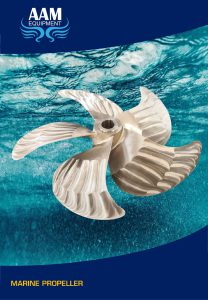
AAM MARINE PROPELLERS
Calculations
Because choosing the right propeller is crucial for an efficient propulsion system, we specializes in propeller calculation. We can give you a solid, thorough advice on the right propeller in your specific situation.
Propellers Shapes & Sizes
We offer have a very wide range of propellers to choose from. We offer propellers:
– In almost any kind and for every application imaginable, varying from standard propellers to propellers for displacement, sailing or plaining vessels.
– In diameters measuring from 5″ up to almost 5 meters.
– In all known materials like Mn.Br, Ni.Al.Br. and stainless steel.
– With approval of various classi cation societies, e.g. LR, BV, ABS, DNV, GL etc.
These propellers are designed with CAD/CAM-technology and fabricated with CNC machines. This contributes to a higher efficiency, less vibrations, a lower noise level and less fuel consumption.
Free Rotation Of The Propeller
After the diameter of the propeller has been determined, it is very important to know whether this propeller can be fitted. To prevent vibration it is absolutely necessary to take into account certain clearances of the propeller. Clearance of the propeller needs to be 15% of the diameter of the propeller at the top and 4% at the bottom.
Efficiency Propellers
Type EP
They are made of manganese bronze (Mn.Br.). These propellers comply to the ISO 484/2 class II
tolerances and are dynamically balanced. We always keep 3B and 4B propellers in common dimensions
on stock, just to ensure you quick deliverance. In most situations Mn.Br. is a good material for propellers. But when it comes to aluminium vessels, we advise the use of a nickel aluminium bronze propeller. Manganese bronze contains up to 40% of zinc, which always causes galvanic problems when used with aluminium. Nickel aluminium bronze is free of zinc, so this will not cause any troubles. If there is a lot of cavitation, or if the engine is very powerful, we advise nickelaluminium bronze as well.


